Sunlight prevents breast cancer. By Marc Sorenson, EdD.
Sunlight prevents breast cancer by many means. Many scientists believe this. Moreover, sunlight also stimulates human skin to produce vitamin D. Therefore, many professionals assume vitamin D is responsible for the reduced risk. Thus, this may lead them to advocate the use of vitamin D supplementation and totally miss the bigger picture. In addition to vitamin D, sunlight or sunlamps produce many supplementary and healthful photoproducts. Among others, sunlight produces nitric oxide, dopamine, serotonin, endorphin and brain-derived neurotropic factor (BDNF). In addition, all these photoproducts are vital to health. Hence, it is likely that these healthful photoproducts lead to an inhibition of breast cancer.
New research shows that sunlight prevents breast cancer independently of vitamin D.
Consequently, it should not surprise us that for breast cancer, sunlight’s effects go beyond vitamin D. Researchers at Children’s Hospital Oakland Research Institute, used a mouse model that easily develops breast cancer. They also treated them with UVR light such as found in sunlight. Much as we might expect, they found that UVR treatments produced significant anti-cancer effects. Furthermore, they found that neither dietary vitamin D nor topical vitamin D influenced cancer risk. Because of their findings, they stated the following: “UVR’s inhibitory effects occur irrespective of whether or not the treatment increases circulating D3 in the mice.” Then they also made another important comment regarding their research. “Therefore, supplemental D3 may not mimic all possible beneficial effects of UVR. Uncovering non-D3-mediated mechanisms of UVR tumor inhibition may lead to novel strategies for cancer prevention.”
An important point about how sunlight prevents breast cancer.
Finally, there is no doubt that vitamin D has anticancer benefits. This research however, is especially relevant because it corroborates what I have said in my book, Embrace the Sun. Consequently, we must not put all of the benefits of sunlight in the vitamin D box. Furthermore, sun exposure performs myriad miracles beyond vitamin D. One of those miracles may be breast cancer prevention and inhibition. In addition, if we erroneously believe we can obtain all of the sun’s benefits from popping a pill, we may miss the holistic effects sunlight, which provide a cornucopia of salubrious results.
So, safely (without burning) embrace the sun, since it helps prevent breast cancer.
For more information, visit sunlightinstitute.org. Another great tip is to read the book, Embrace the Sun.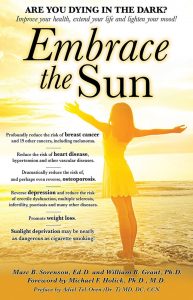
Happy sunning!
The phone, sunlight and sound sleep. By Marc Sorenson, EdD. 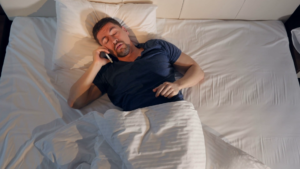
The phone is ubiquitous, and it may be taking away a basic human need: sound and restful sleep.
How should the sleep/wake cycle work?
First of all, we awake to bright sunshine. Light enters the eye and stimulates serotonin production. Serotonin is a natural “upper” and mood elevator. Thus, we quickly become awake and invigorated. The bright sunshine also suppresses melatonin, the sleep inducer. Yet at evening light disappears (at least that is how nature intended it), melatonin levels rise, and serotonin levels diminish. We begin to feel sleepy and ideally retire for a good night’s rest. It is a perfect system for our needs—unless we stay up beyond biologically natural hours by using artificial lighting.
Then, the phone throws a wrench into the works!
Particularly, a phone, tablet, computer monitor and other electronic device that emits blue light can interfere with sleep cycles. This may leave you wide-awake and staring at the ceiling when you should be sleeping peacefully. Furthermore, you may feel “out of sync” the next day due to lack of rest. We hear a plethora of advice about using blue-blocker screens, and heaven forbid, giving up the devices at night! Regrettably, however, some humans would rather die than not check their devices just before, and many times during, bedtime. Perhaps they are incorrigibly addicted to the phone, tablet, etc. In addition, such activities inhibit melatonin secretion. Best to eschew the phone by night and embrace the sun by day!
So, is there any way to cater to our phone addictions and still get some shut-eye?
An interesting study showed that exposure to constant bright light, for several hours daily, stopped sleeplessness and let melatonin dominate at night. The researchers compared subjects reading a book (no blue light) and a tablet (lots of blue light). They also assessed sleep patterns and melatonin concentrations. Both groups had identical results for melatonin and sleep patterns. From this research, it appears that we can have our cake and eat it too, provided we receive plenty of sunlight. Most noteworthy was that it was not lack of blue light (when the devices were removed) that enhanced sleep. Rather, it was the bright light exposure in the day. Hence, we can evade sleep-deprivation punishment for  excessive device use if we take our time in the sunlight!
excessive device use if we take our time in the sunlight!
So is there other research indicative of the night-time-sleep-inducing effects of daytime sun exposure?
There are several. For a full discussion, I suggest you read my book, Embrace the Sun, co-authored by Dr. William Grant.
Another investigation established that people whose workplaces have windows are able to sleep about 46 minutes per night longer on average, than those who have no natural light access. Those with windows also are generally happier, have fewer ailments, and experience better vitality than their window-less counterparts.
Why is sleep so important to health, regardless of cell phone, sunlight, etc.?
Another article shows that too little sleep can be deadly. Forbes Magazine online printed an excellent article on sunlight and sleep, which listed the following horrendous statistics: “In 2012, 60 million Americans filled prescriptions for sleeping pills, up from 46 million in 2006.” The article discusses the potential dangers of sleep medications, showing that those who take 18 sleeping pills per year have a tripling of the risk of death compared to those who take fewer than 18.
Do not expect the drug companies to be touting these stats. Take matters in your own hands and get some daily, non-burning sun exposure. In addition, read Embrace the Sun,
New Melanoma Incidence, by Marc Sorenson, EdD
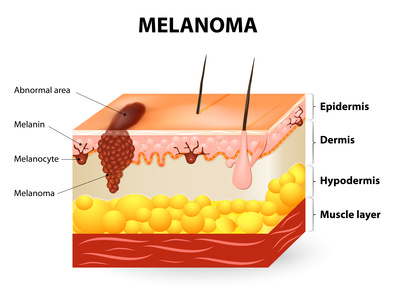
New melanoma incidence, first of all, should be highest in states with the highest sun exposure. That is, of course, if we listen to the dermatological organizations and sunscreen manufacturers. Those organizations state ad nauseam that new melanoma is caused by sun exposure, and the facts be damned. Because both of these sunscreen pushers are financially involved in the anti-sun message, they seem little interested in the truth. Why? Because the truth sells few sunscreens.
Insurance companies should be a good source for information on new melanoma rates and risks.
However, new information, which refutes the anti-sun message, continues to emerge and throw a wrench into the works. Insurance companies, who must pay a fortune in insurance costs for new melanoma, probably know the truth about the disease. So, let’s look at one of those latest assessments. Quote wizard Insurance news released a study on new melanoma rates by state, and it probably stunned the anti-sun lobby. Furthermore, they stunned themselves with what they discovered. So, here are their major findings as listed in their report:
- Opposite of what was expected, cooler, northern states have the highest rate of new melanoma cases.
- In addition, warmer, southern states actually have lower rates.
- Furthermore, behaviors in sun protection are likely the biggest factor inmelanoma cases (I vehemently disagree!).
- Finally, males are disproportionately affected compared to women.
Don’t mess with Texas when it comes to new melanoma cases.
Another stunner was that the fewest cases were in Texas. The highest number of cases were in Utah, followed closely by Vermont, Minnesota and New Hampshire.
It is rather interesting that the authors tied themselves in knots trying to explain away their findings. Hence, they tried to make the case that people residing in warmer areas had learned to avoid the sun. And, they had also learned to use protective measures to a greater extent than those who dwelt in cooler areas. That is rather silly. Why? Because we know that sunscreen use increased 400% in the past four decades, while melanoma also increased by 400%. And even more impressive, go back a few more years to 1935. We find that since 1935, sun exposure decreased by 90%, while melanoma increased by 3,000%!
The bottom line regarding new melanoma:
So let’s face the facts: regular, non-burning sun exposure protects against melanoma, new or otherwise. Only occasional blasts of sun to an unprepared body (a practice that is rather mindless), can lead to the disease. Consequently, be sure to gradually work into regular, safe, non-burning sun exposure to protect against becoming a melanoma case.
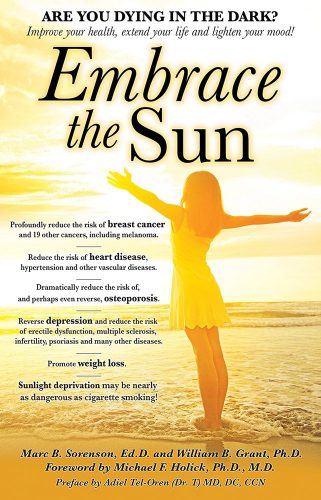
Finally, to get the entire story about the health benefits of sunlight, visit http://sunlightinstitute.org/. Also read my new book, Embrace the Sun, coauthored by Dr. William Grant. Happy sunning!
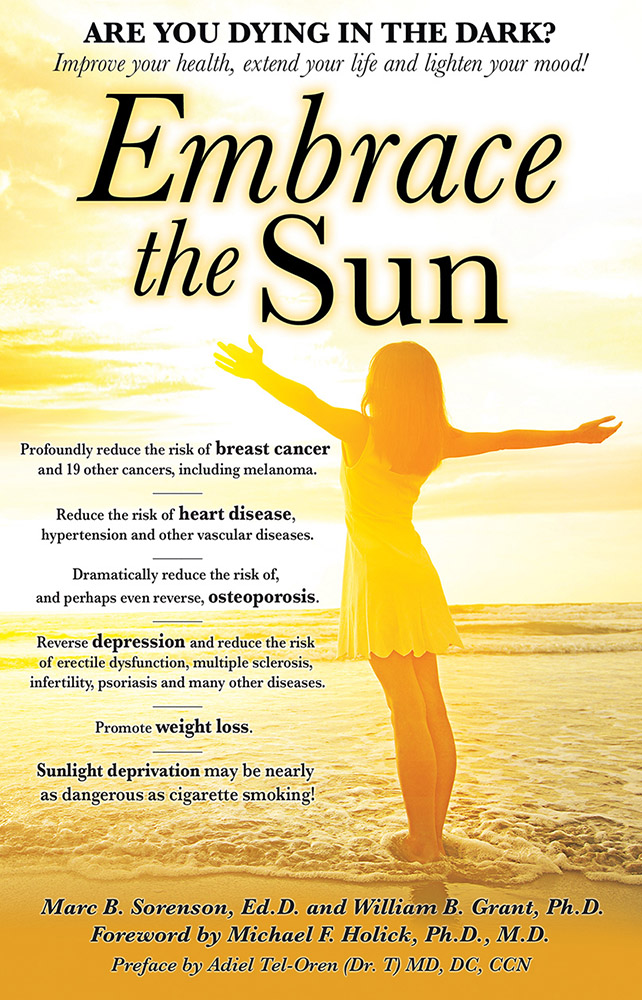 New book, Embrace the Sun, recommends non-burning sun exposure, citing research on sun exposure, vitamin D, and disease risk.
New book, Embrace the Sun, recommends non-burning sun exposure, citing research on sun exposure, vitamin D, and disease risk.
Available on Amazon, Embrace the Sun, by authors Marc B. Sorenson, Ed.D. and William B. Grant, Ph.D., claim that sun avoidance may be nearly as hazardous to your health as cigarette smoking! Will there soon be a Surgeon General’s warning about staying indoors or putting on too much sunscreen? Is this book based on science or pure science fiction?
The book is based on science and research. Together, Sorenson and Grant have worked 62 years studying and practicing health, nutrition, and the proper relationship with sunlight. A mountain of evidence exists showing that sunlight can promote weight loss, reduce depression, and profoundly decrease the risk of today’s common diseases including most cancers, heart disease, autism, diabetes, osteoporosis, multiple sclerosis, infertility, preterm birth and psoriasis. Do I have your attention? This book provides solid evidence towards a case for regular, sensible sun.
“Marc Sorenson and Bill Grant take us on a delightful journey to better understand the health benefits of our magnificent sun at a time when our sun has been demonized by various health organizations, including the dermatology community, which has been essentially unchallenged for the past 50 years,” said Michael F. Holick, Ph.D., M.D., Boston University Medical Center, “Embrace the Sunis an easy read that is chock-full of valuable information about the health benefits of sensible sun exposure. It provides a very practical guide on how to take advantage of our Magnificent Sun.”
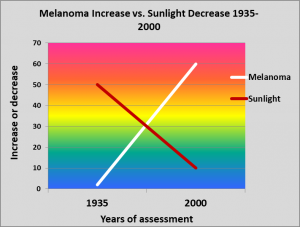 According to the book, 75% of all melanomas occur on areas of the body that are seldom or never exposed to sunlight. Additionally, sun exposure has decreasedby about 90% in the U.S. population since 1935. During that same period, melanoma incidence has increasedexponentially, by approximately 3,000%! This evidence debunks the myth that melanoma is caused primarily by the sun, and instead suggests that the disease is at least partially caused by sun deprivation.
According to the book, 75% of all melanomas occur on areas of the body that are seldom or never exposed to sunlight. Additionally, sun exposure has decreasedby about 90% in the U.S. population since 1935. During that same period, melanoma incidence has increasedexponentially, by approximately 3,000%! This evidence debunks the myth that melanoma is caused primarily by the sun, and instead suggests that the disease is at least partially caused by sun deprivation.
“This book is a tour de force for health effects of exposure to the sun,” said Cedric F. Garland, Dr. Ph. F.A.C.E., University of California at San Diego. “It is written simply enough and in such a light-hearted vein that any intelligent fifth grader can and should read it. It also should be required reading for every upcoming doctor in training and all health care professionals.”
Sorenson and Grant prepare the reader to make an informed choice. With summer coming, is it wise to get out regularly at midday, exercise, and soak up some rays? Or better to stay indoors, continuing the current regimen? Could it be that something so central to nature, the sun, which has been part of the human race for thousands of years is now bad for us? In this blip that is the late 20thand beginning 21stcentury has sun avoidance been helpful or hurtful? Read Embrace the Sun and find out!
About Marc B. Sorenson, Ed. D.
Dr. Sorenson is a doctor of education (EdD) with a health background. He and his wife, Vicki, developed one of the world’s top resorts (National Institute of Fitness). During 20 years, their clients lost over 100 tons of fat; two thirds of diabetic guests were freed of medication in two weeks; and others recovered from cholesterol, arthritis, and myriad additional maladies. Sorenson has written ten books and hundreds of blogs for his site, Sunlight Institute. On the recommendation of Senator Orrin Hatch, a flag was flown over the U.S. Senate building to honor his contributions to world health.
About William B. Grant, Ph.D.
Dr. William Grant is an epidemiologist and founder of the nonprofit organization Sunlight, Nutrition and Health Research Center. Grant holds a PhD in Physics from UC Berkeley and worked as a senior research scientist in the field of optical and atmospheric sciences at SRI International, JPL, and NASA Langley.
He published the first paper linking dietary factors to risk of developing Alzheimer’s disease in 1997. Since 2000, he has focused on ultraviolet-B (UVB) radiation and vitamin D and their relation to cancer and other diseases. He has written over 256 peer-reviewed articles, editorials, and letters to the editor on vitamin D and health.


